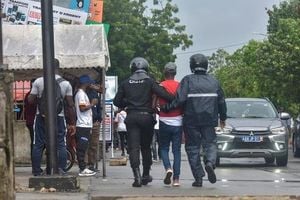Cellin Gluck, a Hollywood director with credits including Oba: The Last Samurai and Persona Non Grata, has been awarded at least $2.2 million by a jury after being struck in the face by a less-lethal munition fired by a Los Angeles sheriff’s deputy during a protest in May 2020. The verdict, delivered last week, found Los Angeles County liable for the injuries Gluck sustained during a demonstration against police brutality following the killing of George Floyd in Minneapolis—a moment that sparked nationwide protests and soul-searching about law enforcement tactics.
The jury determined Gluck suffered $3.5 million in damages, but because they found that Gluck and other protesters at the scene were partly at fault, the court reduced the award by 35%, as reported by the New York Post. This means Gluck will receive about $2.27 million. His daughter, who was with him that day, was awarded $300,000 for emotional distress, also reduced by 35%, bringing her total to $195,000. Los Angeles County lawyers said in a statement, “The County is exploring all of its options in this case, including the possibility of an appeal.”
According to legal filings and court testimony, Gluck and his daughter were returning to their car after leaving the protest when they approached a fellow demonstrator who appeared to be in distress. That protester told them he had just been hit in the face with a beanbag round. Moments later, Gluck himself was shot in the face with a nonlethal projectile. The only thing in his hands at the time was a camera, according to court documents. “The force of the impact snaps his head backwards causing him to fall backward onto the ground,” Gluck’s lawyers wrote in a trial brief. “He is unarmed, is not engaged in any violent or assaultive conduct.”
The projectile’s impact was devastating. It traveled up Gluck’s nasal cavity and remained lodged there for almost an entire year, requiring surgical removal. The injuries left Gluck, now 67, with permanent disfigurement, a traumatic brain injury, and other lasting consequences. His attorney, Carl Douglas, emphasized the severity of the ordeal. “He is a 67-year-old man whose doctors have said he will have to manage the consequences of his injury for the rest of his life,” Douglas said. “This amount of money will not adequately compensate him for the injuries he continues to endure every day.”
Gluck’s story is just one example of the scrutiny law enforcement agencies have faced over the use of so-called less-lethal munitions to control crowds. In the months following the George Floyd protests, incidents involving rubber projectiles, beanbags, and other crowd-control devices have come under increased legal and public examination. According to Los Angeles Times reporting, journalists and other members of the media have also been injured during protests. This led a federal judge to grant a temporary restraining order blocking Los Angeles police from using rubber projectiles and other less-lethal munitions against journalists—a move hailed by press freedom advocates.
For Gluck, the incident was not just a personal tragedy but a flashpoint in a larger debate about police accountability. His attorney, Carl Douglas, argued that law enforcement training specifically instructs officers not to target individuals above the shoulders with these types of munitions unless there is a deadly threat. The inability of Los Angeles County officials to identify the specific deputy responsible for firing the projectile that struck Gluck was, in Douglas’s words, “a tremendous indictment on the county and the system.” He added, “Until they are held accountable for their actions, there will continue to be verdicts by the people of Los Angeles trying to send a message to their law enforcement agencies to do better.”
The Los Angeles County Sheriff’s Department, in response to the verdict, pointed out that a different administration is now in charge but acknowledged the need for introspection. In a statement, the department’s leaders said they “recognize the importance of thoroughly reviewing and evaluating what occurred at that time to identify lessons that can help us improve our service to the community.”
The use of less-lethal munitions has not only affected protesters but also bystanders and journalists. In a separate incident, another protester filed a civil rights claim after losing a finger to a less-lethal munition during a demonstration that was part of the nationwide “No Kings” protests. Under California law, anyone seeking to file a civil rights lawsuit against a city or county for police misconduct must first file an official claim—a process designed to give municipalities a chance to settle disputes before they reach the courts.
Gluck’s case also touches on the broader issue of how law enforcement agencies respond to mass protests—particularly those ignited by high-profile incidents of police violence. The May 2020 demonstrations in Los Angeles were part of a wave of protests across the country, many of which were met with aggressive police tactics. The federal government’s deployment of agents to cities like Los Angeles during the Trump administration’s crackdown on illegal immigration further heightened tensions, leading to more confrontations and, inevitably, more injuries.
In the aftermath of these events, legal challenges and policy changes have begun to reshape the landscape. The federal restraining order preventing Los Angeles police from using rubber bullets against journalists and media members is just one example of how the courts have stepped in to protect civil liberties. Yet, for those like Gluck who have already suffered life-altering injuries, legal victories offer only limited solace.
Gluck, whose filmography includes directing and producing works such as Oba: The Last Samurai, Persona Non Grata, Sideways, Marmaduke, and Into The Sun, has become an unexpected symbol in the ongoing debate over protest policing. His experience underscores the physical and emotional costs that can result from the use of force at public demonstrations—and the complex legal battles that often follow.
Los Angeles County, for its part, is weighing its next steps. In their statement, county lawyers reiterated that “the County is exploring all of its options in this case, including the possibility of an appeal.” The outcome of any appeal could have broader implications for how similar cases are handled in the future, both in Los Angeles and elsewhere.
For now, Gluck and his daughter have received a measure of justice, though, as his attorney pointed out, the compensation can never fully restore what was lost. The verdict stands as a stark reminder of the human consequences of crowd-control tactics and the enduring need for law enforcement accountability in moments of crisis.




